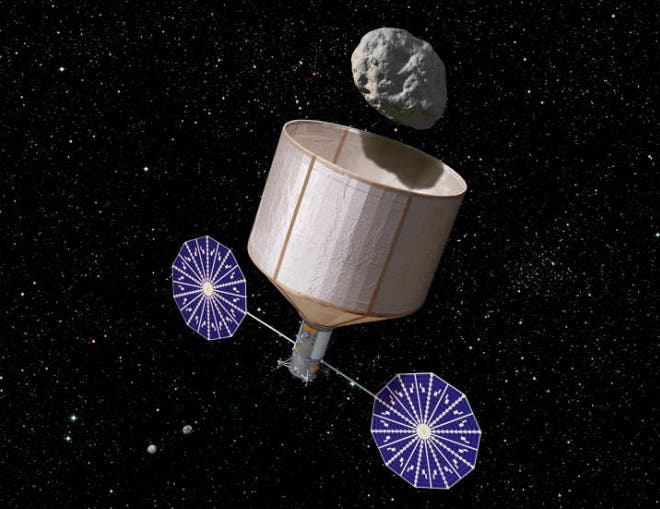
An ambitious project is currently being considered by NASA consisting of capturing and dragging a small-scale asteroid into the moon’s orbit. This would allow for a valuable footing where asteroid research might become a lot more accessible, one of NASA’s main objectives for the upcoming decades.
The proposition has been made by the Keck Institute for Space Studies and was detailed in a publicly available report. The report follows the prospects of snaring a small 7-meter wide asteroid from nearby with an unmanned robotic probe, which would catch the asteroid in a “bag” measuring about 10 metres by 15 metres and haul it into lunar orbit. The researchers involved in the proposition claim the benefits far outweigh the risks, providing valuable insights into asteroid research, while also extending humanity’s footing in the solar system on its way to Mars. If the $2.6 billion plan is approved by NASA then it could go live as soon as 2025.
“The best way for NASA to reach both its asteroid goal and to launch humans into trans-lunar space — beyond the moon — is to use a robot spacecraft to retrieve and return to a safe lunar orbit a small, 500-ton asteroid,” former astronaut Tom Jones, author of the upcoming book “Mission: Asteroid,” told Space.com. “Astronauts and robot probes can explore and dissect this asteroid for science and commercial-scale resources… water being the most valuable.”
Important techniques and skills might become acquired, especially those that imply touching base with an asteroid like complicated flying and landing maneuvers. Studying an easily accessible captured asteroid would teach scientists a great deal about how asteroids can be drilled and have their resources exploited. Last year we told you all about an audacious plan where the prospect of asteroid mining was and still is being discussed. Trillions and trillions of dollars in valuable resources like platinum and rare minerals can be extracted from asteroids, and the corporate world has its eye well fixed on this idea. Make no mistake, however, the most valuable commodity asteroids have to offer in space is water. Learning how to properly extract, store and use water captured from asteroids is an invaluable skill if humans are to cross pass the moon’s outer orbit.
If coupled with an eventual stationary manned outpost on the far side of the moon – also envisioned by NASA – valuable results and insights might follow.
“Extraction of propellants, bulk shielding and life support fluids from this first captured asteroid could jump-start an entire space-based industry,” the Keck team writes. “Our space capabilities would finally have caught up with the speculative attractions of using space resources in situ.”
Since President Obama came to office in 2008, NASA’s top priority has become space exploration beyond the comfortable close Earth orbit. n 2010, President Barack Obama directed the agency to get astronauts to a near-Earth asteroid by 2025, then on to the vicinity of the Red Planet by the mid-2030s. The Keck plan seems on par with these objectives, however it still remains no more than a proposition, and an official answer from NASA will most likely not come too soon.






